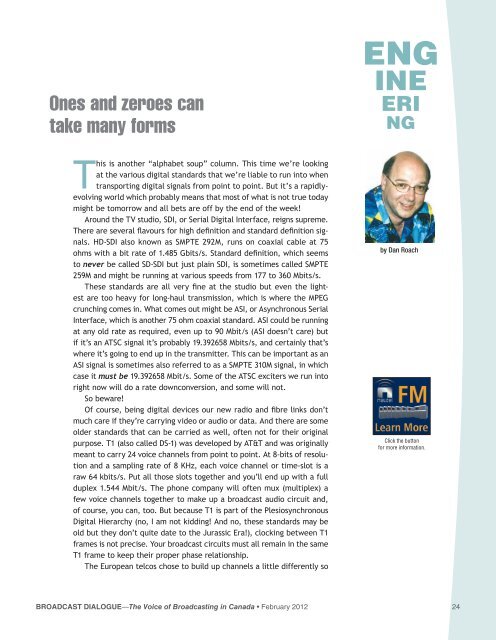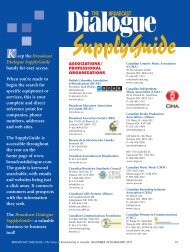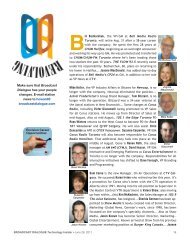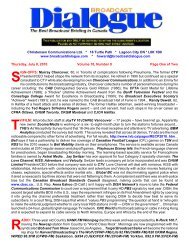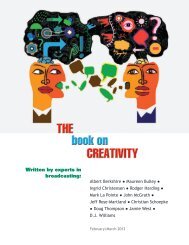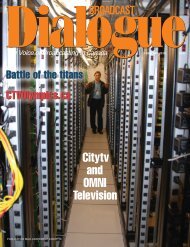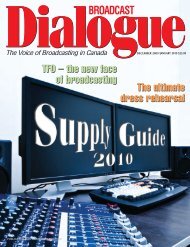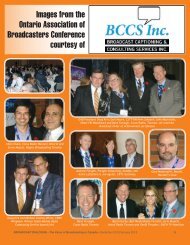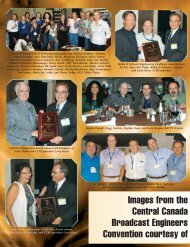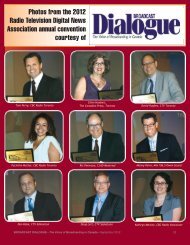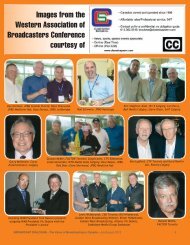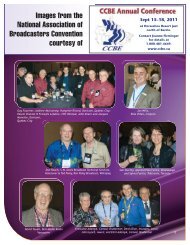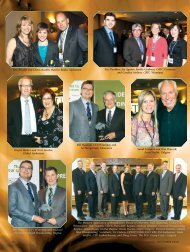Current PDF Edition - Broadcast Dialogue
Current PDF Edition - Broadcast Dialogue
Current PDF Edition - Broadcast Dialogue
Create successful ePaper yourself
Turn your PDF publications into a flip-book with our unique Google optimized e-Paper software.
Ones and zeroes can<br />
take many forms<br />
ENG<br />
INE<br />
ERI<br />
NG<br />
This is another “alphabet soup” column. This time we’re looking<br />
at the various digital standards that we’re liable to run into when<br />
transporting digital signals from point to point. But it’s a rapidlyevolving<br />
world which probably means that most of what is not true today<br />
might be tomorrow and all bets are off by the end of the week!<br />
Around the TV studio, SDI, or Serial Digital Interface, reigns supreme.<br />
There are several flavours for high definition and standard definition signals.<br />
HD-SDI also known as SMPTE 292M, runs on coaxial cable at 75<br />
ohms with a bit rate of 1.485 Gbits/s. Standard definition, which seems<br />
to never be called SD-SDI but just plain SDI, is sometimes called SMPTE<br />
259M and might be running at various speeds from 177 to 360 Mbits/s.<br />
These standards are all very fine at the studio but even the lightest<br />
are too heavy for long-haul transmission, which is where the MPEG<br />
crunching comes in. What comes out might be ASI, or Asynchronous Serial<br />
Interface, which is another 75 ohm coaxial standard. ASI could be running<br />
at any old rate as required, even up to 90 Mbit/s (ASI doesn’t care) but<br />
if it’s an ATSC signal it’s probably 19.392658 Mbits/s, and certainly that’s<br />
where it’s going to end up in the transmitter. This can be important as an<br />
ASI signal is sometimes also referred to as a SMPTE 310M signal, in which<br />
case it must be 19.392658 Mbit/s. Some of the ATSC exciters we run into<br />
right now will do a rate downconversion, and some will not.<br />
So beware!<br />
Of course, being digital devices our new radio and fibre links don’t<br />
much care if they’re carrying video or audio or data. And there are some<br />
older standards that can be carried as well, often not for their original<br />
purpose. T1 (also called DS-1) was developed by AT&T and was originally<br />
meant to carry 24 voice channels from point to point. At 8-bits of resolution<br />
and a sampling rate of 8 KHz, each voice channel or time-slot is a<br />
raw 64 kbits/s. Put all those slots together and you’ll end up with a full<br />
duplex 1.544 Mbit/s. The phone company will often mux (multiplex) a<br />
few voice channels together to make up a broadcast audio circuit and,<br />
of course, you can, too. But because T1 is part of the Plesiosynchronous<br />
Digital Hierarchy (no, I am not kidding! And no, these standards may be<br />
old but they don’t quite date to the Jurassic Era!), clocking between T1<br />
frames is not precise. Your broadcast circuits must all remain in the same<br />
T1 frame to keep their proper phase relationship.<br />
The European telcos chose to build up channels a little differently so<br />
by Dan Roach<br />
Click the button<br />
for more information.<br />
BROADCAST DIALOGUE—The Voice of <strong>Broadcast</strong>ing in Canada • February 2012 24


